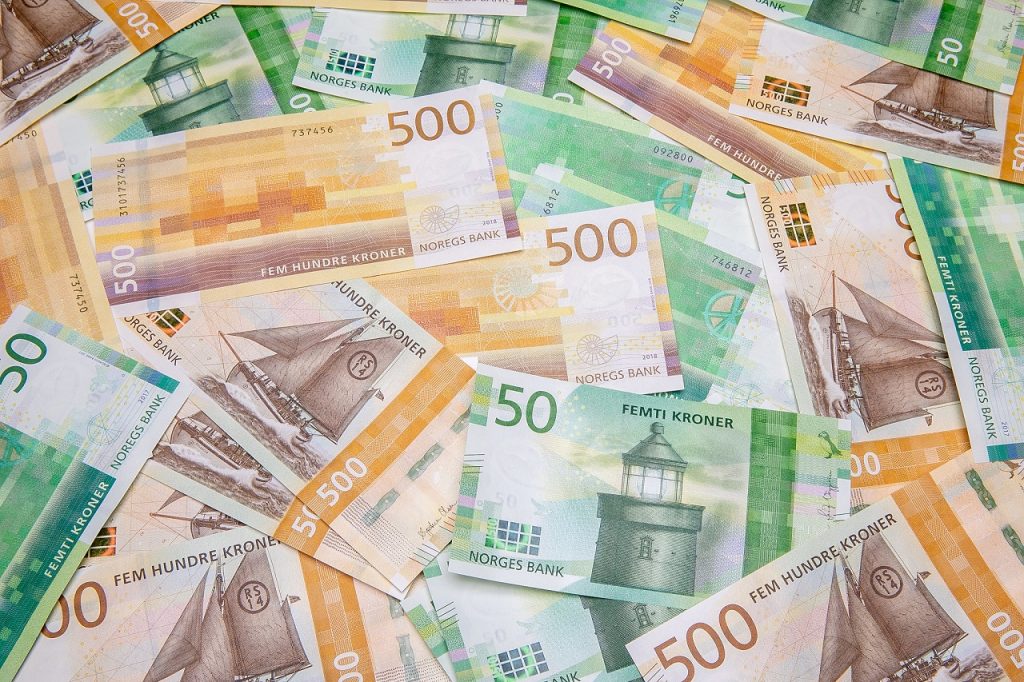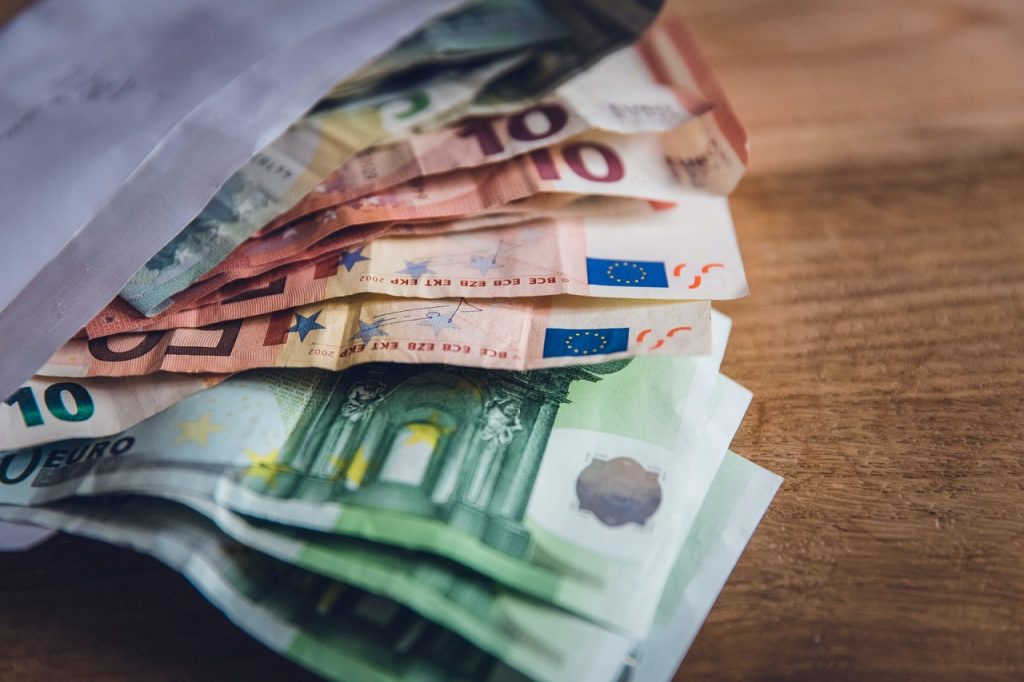Norway’s official currency is called Norwegian krone (krone can be translated to crown), and it’s the only legal currency in Norway. You will have to deal with Norwegian kroner (NOK) when visiting Norway, since all stores will accept this currency, and all prices are displayed in NOK.
Since you will have to deal with Norwegian kroner (kroner is the plural of krone) when visiting Norway, we’re going to take a deep-dive into what the Norwegian krone is like, it’s history, and why Norway still uses its own currency.
So keep on reading if you’re planning a trip to Norway, or just want to learn a bit about Norwegian currency, its history, and how it shapes Norwegian culture.

It’s worth noting that while the official short name for Norwegian krone is NOK, the price is usually written as X kr or X,-. You will see that the price tags often say things like 99,- instead of 99kr. This has to do with when the krone was worth a lot less, and you had to pay in øre (a division of krone where 100 øre = 1 krone). So ,- simple means “point zero”, and has become a standard way of writing prices in Norway.
The value of Norwegian krone
The Norwegian krone is independent from all other currencies, so it’s valued compared to USD or Euro will change all the time. As of May 2022, the value of the Norwegian krone is very low compared to Euro or United States Dollars.
$1 USD is worth around 9.6 NOK, while €1 is worth 10.2 NOK.
So at least it’s very easy to do calculations in your head if you’re visiting Norway from either the US or any European country, and want to find out how much it cost in your local currency.
Just divide the NOK sum by 10 to get a very close approximation to what the value is in either Euro or USD.
The exact value of NOK compared to USD or EUR will obviously change all the time, so make sure to check out the current trade value if you read this post in late 2022 or even further into the future.
To get a real-time update of the exact value, check out Norges Bank’s website for NOK to USD value or NOK to EUR value. Norges bank is the official bank of Norway, which again is responsible for the Norwegian krone, so their prices should be the most correct ones.
The different denominations of Norwegian krone
Norwegian kroner have denominations from one single krone to a bank note worth 1,000 Norwegian kroner. There are a total of 4 different coins (1 NOK, 5 NOK, 10 NOK and 20 NOK) and 5 different bank notes (50 NOK, 100 NOK, 200 NOK, 500 NOK and 1,000 NOK) that are all used.
You can split a Norwegian krone into a smaller unit, similar to how you can split a dollar or euro into cents. This smaller unit of the krone is called an øre (can be translated to ear).
Øre is a bit of a weird thing these days. 1 øre is 1/100 of a NOK, so it’s virtually without value nowadays. There are no longer any coins for it, so it only exists digitally. Any time you pay with cash, the sum will be rounded up to the nearest NOK.
So if your total adds up to 99.80 NOK, it will be rounded up to 100 NOK when you pay with cash. However, if you pay digitally by a banking card, only 99.80 NOK is charged from your account.
The different NOK coins
Norwegian krone coins are not commonly used, and their value in an expensive country like Norway is pretty low. However, there are 4 different coins that you can come across on your visit to Norway, and you can see the front and back of the coins on the photo below.

1 NOK coin: The motive is from Hylestad Portals, a portal entryway to the old Hylestad Stave Church.
5 NOK coin: The design is from the crest of St. Olavs Orden, a medal given to soldiers for certain military actions. The front side is inspired from the Acanthus plant.
10 NOK coin: The front has a picture of the roof of a stave church. Back is the portrait of King Harald the 5th.
20 NOK coin: The front has a picture of a viking ship, and the back is the same as the 10 NOK; a portrait of King Harald the 5th.
The different NOK bank notes
All the Norwegian bank notes were issued between 2017 and 2019, so these are all brand new to us. The denominations are still the same, and you can find Norwegian bank notes in denominations of 50 NOK, 100 NOK, 200 NOK, 500 NOK or 1,000 NOK.
Mot people are pretty happy with the new and modern design on the bank notes, even though cash is rarely used in Norway these days.
The photo below show the different banking notes.

50 NOK bank note: This bank note has a picture of Ulvær Lighthouse on it, and is a light green color.
100 NOK bank note: The light red bank note has a picture of the famous Gokstad viking ship on it.
200 NOK bank note: The 200 NOK bank note has a picture of the cod on it, meant to symbolize how the sea is an important factor for food. The note is light blue.
500 NOK bank note: Has a picture of the RS 14 Stavanger ship, an early Norwegian Rescue Ship. The note is light yellow colored .
1,000 NOK bank note: Has a picture of a wave on it, and is a light purple color.
PS. the old banking notes used until 2019 are no longer in circulation, so these cannot be used to pay anymore. If you own any of these, visit a bank and ask to trade it to a new bank note.
Why Norway doesn’t use Euros, and won’t accept it as payment
Some people are surprised that we do not use Euro here in Norway, which is a bit strange to be honest.
The simple reason why Norway does not use Euro is because Norway is not a member of the European Union. It would make no sense for Norway to start having euro as a currency.
Norway also prefers to keep its currency tied to its own economic (that can be controlled by oil supply) instead of having to rely on the well-being of the entire EU to keep a healthy economy.
Some tourist shops and souvenir shops aimed at foreigners will accept euro as a payment method, but this is something they offer as a service, not because they have to. And if you have the choice, always pay in NOK (all store are legally required to accept NOK). This allows your bank to choose the conversion rate instead of the shop itself, which will absolutely save you some money.
So buy all your Norwegian souvenirs in Norwegian kroner if you want them as cheap as possible!

Norway is a mostly cashless society
Many people are surprised to learn that most Norwegians rarely use cash at all anymore, and pretty much over 99 % of all transactions are digital. All stores have banking terminals, and mobile payments are growing very common. I can’t really remember the last time I paid with cash myself.
Norway uses a system called BankAxept that allows any banking card to be used at any payment terminal, so you never really have any trouble with using Norwegian bank cards to pay for anything.
This has lead to the fact that most younger people not really having much of a knowledge about cash at all, and many Norwegian still haven’t really seen or used the “new” bank notes that were released in 2019.
Read more about payment methods in Norway here.
Foreign credit cards are not as reliable as Norwegian credit cards are, so I advise all tourists in Norway to find an ATM and withdraw some cash to have just in case your card does not work.
Vipps digital payment
A pretty new mobile payment app has taken Norway with storm, and it’s called Vipps. This is very popular in Norway, and you will find that most stores are now accepting Vipps as a payment method. It started as an app to send small amount of money between friends, but you will now find that it’s very common to use for paying in stores, when online shopping, or when buying used items from other people.
Vipps is also tied directly to a Norwegian bank account, and operates with Norwegian krone only. It is currently not possible to get Vipps as a foreigner, so all tourists have to just let this one go and find alternative ways of paying.

The history of Norwegian krone
Norwegian kroner were first seen in 1875 as a means of getting Norway into the Scandinavian Monetary Union with Sweden and Denmark. This was an attempt to get all three countries to use kroner as their monetary system, and included a fixed rate for trading them.
This allowed for much easier trade between the three countries, and it was a huge success. The monetary union was dissolved in 1914, but all three countries still use the krone as their currency (so you also have Danish krone and Swedish krona to this day).
There is no longer a fixed trade rate between the different kroner, but they are usually pretty much close to each other. This is especially true for Norwegian krone and Swedish krona (SEK) that are often around 1:1. The Danish krone is typically worth a bit more than the Norwegian or Swedish one.
Originally, smaller denominations were the standard, including going as low as 1 øre coins. However, as with most currencies, inflation kept the numbers growing bigger, so the smallest denominations were gradually phased out. We used to have 50 øre coins back when I was a child in the 90s, but these were removed from the supply a decade ago.
Norwegian krone was and still is a popular currency, and it’s the 14th most traded currency in the world. It is backed by the governmental oil income, so it’s a valuable asset for investors at certain times.

